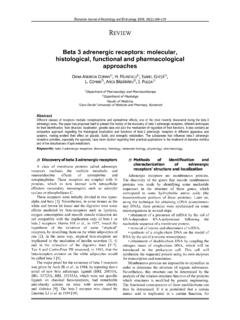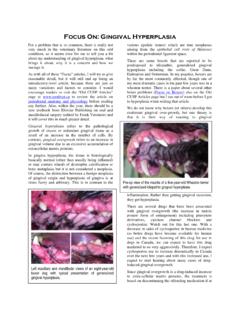Transcription of Hyperplasia, metaplasia, dysplasia and neoplasia …
1 Romanian Journal of Morphology and Embryology 2007, 48(4):335 342 OORRIIGGIINNAALL PPAAPPEERR hyperplasia , metaplasia , dysplasia and neoplasia lesions in chronic cholecystitis a morphologic study MANUELA STANCU1), IRINA-DRAGA C RUNTU1), SIMONA GIU C 2), GIOCONDA DOBRESCU1) 1)Department of Histology, Gr. T. Popa University of Medicine and Pharmacy, Iassy 2)Ist Surgery Clinic, Sf. Spiridon University Hospital, Iassy Abstract The aim of the study was to analyze the association between chronic cholecystitis, premalignant lesions and gallbladder cancer. The group consisted in 3901 cases of cholecystectomies, diagnosed as acute cholecystitis (250 cases ), chronic cholecystitis (3619 cases ) and gallbladder carcinoma (32 cases ). Chronic cholecystitis associated premalignant lesions as follows: hyperplasia in 124 cases ( ), metaplasia in 86 cases (5%) and dysplasia in 10 cases ( ).
2 Only in nine cases, the diagnosis of gallbladder carcinoma was formulated presumptively, before surgery; for the other 23 cases this diagnosis was established after the pathologic exam on the cholecystectomy piece. In the areas adjacent to the neoplastic proliferation, premalignant lesions ( hyperplasia , metaplasia , dysplasia ) were identified in cases. The identification of premalignant modifications in the morphologic background of chronic cholecystitis is an argument in favor of the metaplasia dysplasia neoplasia sequence and justifies recent recommendations for the performing of colecystectomy. Keywords: chronic cholecystitis, hyperplasia , metaplasia , dysplasia , gallbladder carcinoma. Introduction The diseases of the gallbladder represent one of the most frequent medical situations requiring surgical intervention.
3 Cholelithiasis and chronic cholecystitis affect approximately 10% of the adult population in USA, where approximately 500 000 cholecystectomies are performed every year [1]. Frequently, the chronic cholecystitis presents a large range of associated lesions such as cholesterolosis, muscle hypertrophy, parietal fibrosis, polypoid and adenomatous proliferation of mucous glands, metaplasia , hyperplasia and dysplasia the last three lesions being unanimously recognized as precursor lesions with cancerous potential. For the carcinoma of the gallbladder, developed on a background of cholelithiasis [2, 3] and chronic cholecystitis [4 8], the early diagnosis is difficult to obtain due to the absence of specific symptoms [9, 10].
4 Recent studies [6, 11 13] report results obtained on series of cholecystectomies, insisting on the significance of the precursor lesions, as well as on the possibility of accidentally discovering a gallbladder cancer. Tarcoveanu et al. [13] plead for a more firm and precocious indication of cholecystectomy in cholelithiasis, with consequent results in the diminishing of gallbladder cancer incidence and/or diagnosis in incipient stages. The aim of our study was to realize a retrospective analysis on the gallbladder pathology diagnosed between 2005 and 2006 in the Pathology Department of Sf. Spiridon University Hospital Iassy, focusing on the association between lithiasic and non-lithiasic chronic cholecystitis, malignant precursor lesions and gallbladder cancer.
5 Material and methods The study group consisted in 3901 cases of cholecystectomies, performed in the Surgical Clinics of the Sf. Spiridon University Hospital Iassy, in a two-year interval (2005 and 2006). The pathologic exam of the surgical pieces was performed in the Pathologic Department of the hospital. After the macroscopic examination, the fragments were fixed, processed by paraffin embedding and sectioned at 4 microns. The microscopic specimens were colored with routine (Hematoxylin Eosin) and special stains (trichrome van Gieson and Alcian blue). Results Global characterization of the study group In the analyzed series, the pathologic exam of the 3901 cases was acute cholecystitis in 250 cases ( ), chronic cholecystitis in 3619 cases ( ) and gallbladder carcinoma in 32 cases ( ).
6 Manuela Stancu et al. 336 In the chronic cholecystitis cases, the age classification revealed prevalence in the fifth decade of life (1111 cases ) followed by the sixth and fourth decade (740 cases and 652 cases 18%). The seventh and third decade presented comparable values (440 cases and 439 cases , respectively). The female sex was predominantly involved (2874 cases ) as opposed to the male one (745 cases ). From the point of view of the histologic type, the most predominant were ulcerated chronic cholecystitis (1597 cases ), followed by nonspecific cholecystitis (928 cases ), erosive cholecystitis (316 cases ), sclero-atrophic cholecystitis (264 cases ) and polypoid cholecystitis (167 cases ).
7 289 cases (8%) had morphologic features characteristic for associated acute inflammation. In smaller proportions there were also present gangrenous (46 cases ), granulomatous (four cases ) and ulcero-hemorrhagic (eight cases ) forms. The 32 cases of gallbladder carcinoma with a prevalence of the female sex (26 cases ) over the male one (six cases ) were present in the sixth and seventh decade of life; there was a case under 20, one case in the fourth decade and six cases in the fifth decade. From the point view of the histologic type, well-differentiated carcinoma prevailed (11 cases 33%), followed by low-differentiated adenocarcinoma (six cases 19%); moderately differentiated, mucinous and squamous forms were diagnosed in four cases each (13%) and papillary carcinoma in three cases (9%).
8 Association between chronic cholecystitis and premalignant lesions Chronic cholecystitis associated premalignant lesions as follows: hyperplasia in 124 cases ( ), metaplasia in 86 cases (5%) and dysplasia in 10 cases ( ). The hyperplastic lesions were of the villous type, presenting papillary mucous folds (Figure 1), covered by simple columnar epithelium with basal nuclei (91 cases ) and of the spongious type with coalescent villi organizing a glandular pattern (33 cases ). The metaplastic lesions were predominantly of the pyloric type (72 cases from the total of metaplastic cases), characterized by structures similar to the pyloric glands in the lamina propria (Figure 2), followed by the intestinal type (14 cases ), characterized by the presence goblet cells, and enterocit-like cells (Figure 3).
9 The dysplastic lesions, identified in erosive, ulcerated and follicular chronic cholecystitis were of the simple (five cases 50%), moderate (three cases 30%) and severe type (two cases 20%) (Figure 4). Apart from these 10 cases, 17 cases of pyloric metaplasia associated aspects of epithelial dysplasia , involving either an area of the gland (Figure 5) or the entire gland. Gallbladder carcinoma We must stress the fact that only in nine cases ( ) the diagnosis of gallbladder carcinoma was formulated presumptively, before surgery; for the other 23 cases ( ) this diagnosis was established after the pathologic exam on the cholecystectomy piece. In 11 cases ( ), in the areas adjacent to the neoplastic proliferation, premalignant lesions were identified: hyperplasia , metaplasia , dysplasia .
10 Well-differentiated adenocarcinoma was characterized by the presence of glandular or tubular structures (Figure 6), sometimes with acidophilic secretion within the lumen, infiltrating the gallbladder wall. In association there were observed vascular tumoral embolies, perinervous invasion and, in one case, partially rechannelized obliterating arteritis. The cases with moderately differentiated adenocarcinoma presented, together with glandular structures, nests of tumoral cells and/or isolated tumoral cells. Located in a mucosa with massive ulceration on the surface or necrosis, the tumoral proliferation had a parietal invasive pattern (Figure 7). A particular aspect was noticed in one case where, at some distance from the tumoral proliferation, there was an area of reepithelization of the ulcerated mucosa, with dysplastic modifications, as well as a giganto-cellular reaction of foreign body type organized on a necrosis background (Figure 8).







